Day 1 of a 3 day long weekend of tours today. The last of our scheduled Autumn Migration Tours, we were looking to catch up with some lingering migrants and also see the arrival of many of our winter visitors. It was mostly cloudy all day, but not too windy today, good birding conditions for the time of year.
Our first destination of the day was Burnham Overy Staithe. We climbed up onto the seawall and set off to walk towards the dunes. As we did so, we heard Waxwings calling and looked over to the hawthorns further along just in time to see six of them flying off across the path in front of us and heading off west. A nice way to start the day.
The Waxwings had moved on but the bushes were still alive with birds as we walked past. Lots of thrushes were feasting on the berries, probably fresh in from the continent and hungry after their long journey over the sea. There were plenty of Blackbirds and with them a few Redwings and Song Thrushes. Several Robins chasing around in the bushes were also probably winter migrants. Out on the grazing marsh, a flock of Starlings were down in the brambles and a steady stream of small groups of Starlings were passing west overhead.
It was high tide and small parties of Brent Geese were flying around over the harbour or heading out across the grazing marshes. We could see three grey geese half hidden behind a line of reeds out on the grass and looking more closely we could see that they were White-fronted Geese, the white around the base of their bills showing when they lifted their heads.
 White-fronted Geese – three were on the grazing marshes this morning
White-fronted Geese – three were on the grazing marshes this morning
Further along, at the corner of the seawall, we could see loads more geese out on the marshes. They were mostly Greylags, larger and paler with a large orange carrot of a bill, and Pink-footed Geese, smaller and darker grey with a more delicate and mostly dark bill. In with them we found four Barnacle Geese. Unfortunately it is hard to know whether they were wild birds which had arrived with the Pink-footed Geese for the winter, or perhaps more likely feral birds from the flock in Holkham Park!
The geese were mostly distant, but two Pink-footed Geese swam in from the harbour and started feeding on the grass at the bottom of the seawall, giving us a closer look at their pink legs and feet and the pink bank around the dark bill.
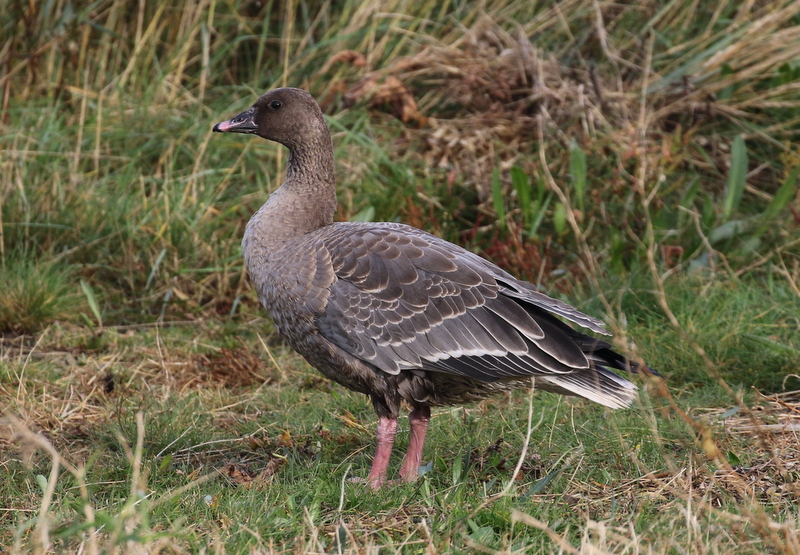 Pink-footed Goose – two were feeding at the base of the seawall
Pink-footed Goose – two were feeding at the base of the seawall
While we were watching the geese, we received a phone call to let us know that a Great White Egret was flying across the harbour behind us. We turned to see it drop down onto the saltmarsh the other side, over towards Scolt Head. Through the scope we could see its long neck and long yellow-orange dagger of a bill. Even at that range, it was clearly much bigger than the Little Egrets, several of which we could see dotted around the harbour.
We made our way swiftly out to the dunes and turned west towards Gun Hill. There were a few photographers with massive lenses lying prone on the grass ahead of us and we could immediately see their target. The Isabelline Wheatear has been here for almost two weeks now. They are a very rare visitor here – breeding from Turkey across through southern Russia, they winter mostly in Africa, so this one was well off course. It seems to be finding plenty of food in the short grass though.
 Isabelline Wheatear – has been in the dunes for almost two weeks
Isabelline Wheatear – has been in the dunes for almost two weeks
The more typical Northern Wheatear is a regular passage migrant here, but Isabelline Wheatear is paler and sandier-coloured. In flight, it has a similar black and white tail pattern, but the black terminal band is much broader. A great bird to catch up with here.
After admiring the Isabelline Wheatear for a while, we set off past Gun Hill and out to the beach. The tide was starting to go out and we could see more waders on the emerging mud. A couple of Grey Plover were feeding in a muddy creek. Several Bar-tailed Godwits were in the water by a sandbank along with two Curlew. Further over, we could see a Ringed Plover and several Dunlin. Small groups of Wigeon had gathered on the banks of the harbour channel.
Walking round onto the other side of the point, we started to scan the sea beyond the spit at the eastern end of Scolt Head. A surprise find here was a late adult Arctic Tern, fishing just offshore. It kept flying up and down just beyond the sand and diving periodically into the water. A Red-throated Diver moulting out of summer plumage drifted east and a juvenile Gannet flew past further offshore.
We had been told that there were some Snow Buntings on the beach, so we walked round along the tide line and eventually spotted nine of them flying towards us. They landed out on the beach at first, but then returned to the high water mark where they proceeded to feed on the piles of saltmarsh vegetation which had been washed up, looking for seeds. We edged closer to them and were watching them through the scope when they flew again – and promptly landed right in front of us. Stunning views!
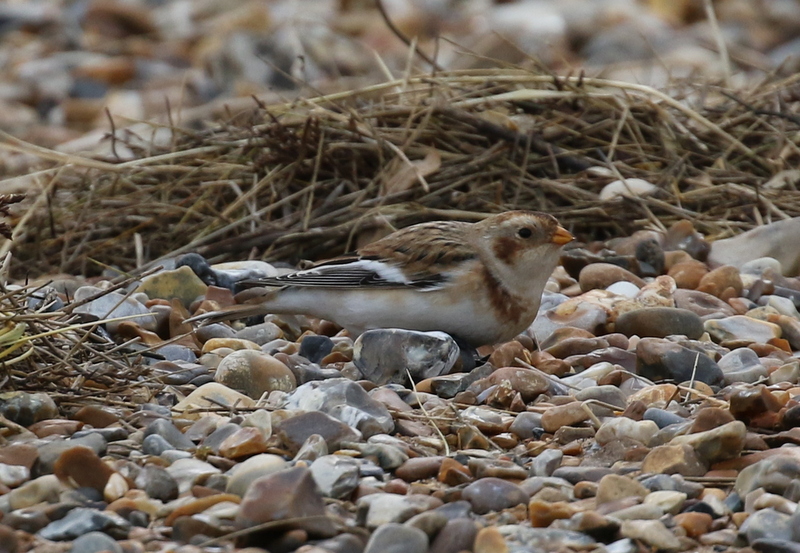 Snow Bunting – there were nine on the beach by Gun Hill today
Snow Bunting – there were nine on the beach by Gun Hill today
We made our way back along the beach, stopping to scan through a nice selection of waders which had gathered around the channels out on the sand north of the boardwalk. The silvery grey and white Sanderling contrasting with the much darker and longer billed Dunlin. More Ringed Plover were walking around on the sandbanks. A Bar-tailed Godwit was wading deeper in the water.
Crossing back over the dunes towards the grazing marshes we could hear birds calling plaintively and looked up to see a small flock of Golden Plover whirling over the grass. They settled down again and we had a look at them through the scope. While we were standing there, a flock of about a dozen Blackbirds came in from the direction of the sea and headed inland. Then three Mistle Thrushes flew in calling too and made their way in over the seawall.
It was time lunch, so we made our way quickly back towards the car. Scanning the grazing marshes on the way, we spotted some birds flycatching from the bushes in the distance. They were Waxwings, possibly the ones we had seen earlier having returned or more likely another group. There are large numbers of Waxwings arriving along the coast at the moment. They are irruptive, coming here in very variable numbers each winter, moving out of Scandinavia in response to cold weather or a lack of berries. After a couple of fairly lean winters for them, this looks like being a good Waxwing year!
We hurried back along the seawall and positioned ourselves where we could see them. The Waxwings were perching in the tops of the bushes and making little sallies up into the air after insects. Others were perched in the hawthorns, preening or eating berries. We counted six out on the grazing marshes at first – then as we walked back along the seawall, four were perched in the bushes just below, and we could still see at least four further over. Waxwings are such stunning birds and full of character with their spiky hairstyles! Suddenly they started calling and flew off towards Burnham Overy Staithe.
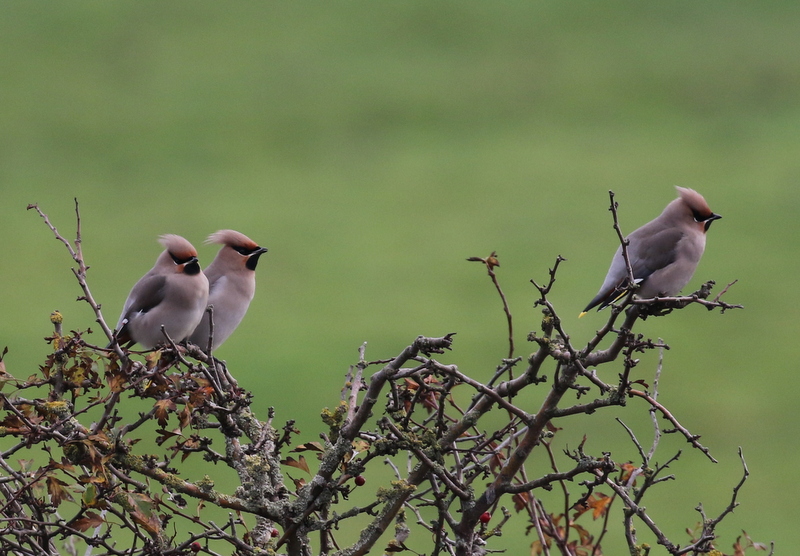 Waxwings – at least 8 were in the bushes on our way back
Waxwings – at least 8 were in the bushes on our way back
After a late lunch at Holkham, delayed due to our time spent admiring the Waxwings, we drove down to the end of Lady Anne’s Drive and walked out through the pines towards the beach. The saltmarshes here used to be a regular site for wintering Shorelarks, but they haven’t been here for nearly five years now. The numbers along the whole Norfolk coast have dropped in recent years and it seemed that seeing large flocks of Shorelarks could be a thing of the past. However, just like with Waxwings it looks like this winter could be a year for Shorelarks. A large flock of Shorelarks has gathered at Holkham in the last couple of weeks.
As we walked down along the edge of the saltmarsh, we could see several people ahead of us. They were not here to see the larks but were walking their dogs – they were off the lead and one of them, a spaniel, was haring about over the whole of the saltmarsh, back and forth. Disturbance from dogs may be one reason why Holkham doesn’t get Shorelarks every year like it used to do. When we got to the place the birds have been favouring, we were pleased to see that some were still left. There were only ten of them though, as we proceeded to stop and admire them.
As we watched them, another flock of about 25 Shorelarks flew back in and joined them. Then another similar sized group returned to. It was hard to count them all, as they were moving all the time and some were hidden in the saltmarsh vegetation but there were at least 62 in total, an amazing number and the most we have seen for many years.
 Shorelark – the Holkham flock numbered at least 62 today, an amazing number
Shorelark – the Holkham flock numbered at least 62 today, an amazing number
While we were watching them, a covey of nine Grey Partridge strolled out of the dunes and across the path and proceeded to feed on the edge of the saltmarsh, next to the Shorelarks. A very odd combination!
Having enjoyed great views of the Shorelarks, we made our way out to the beach. The tide was out but we stopped by the dunes to look at the sea. We could see lots of Common Scoter scattered across the bay, numbering several hundred in total. Closer inshore, we picked up a group of five Long-tailed Duck just off the beach. Before we made our way down to the shore for a closer look, we had a quick scan of the sea.
We got a glimpse of a diver as it disappeared beneath the water and it looked very contrasting, black and white, and we felt sure we had seen a white flank patch. When it finally resurfaced, our suspicions were confirmed – it was a smart winter plumage Black-throated Diver, a nice find as it is the rarest of the three regular UK divers in Norfolk. It was diving all the time, but each time it reappeared we got it in the scope and eventually everyone got a look at it.
By this stage, the Long-tailed Ducks had unfortunately flown further out into the bay, but we still made our way down to the shore. We got a flock of Common Scoter in the scope for a closer look – they appeared to be almost entirely pale-cheeked females/1st winters. Then a more careful look through the various flocks revealed a couple of Velvet Scoters too, larger and darker faced, with two smaller white spots. They were loosely associating with one of the groups of Common Scoter but still keeping to themselves. Conveniently the Velvet Scoter were at the front of the flock which made them easier to pick out.
The sun was already setting and we were starting to lose the light already, so we made our way back across the saltmarsh, the Shorelarks flying in again and landing right beside us as we did so. There was a little group of Brent Geese in the taller vegetation and we stopped briefly for a look through them. One stood out – it had a slightly white flank patch than the others and a somewhat better marked collar.
It was a Black Brant hybrid – not contrasting enough for a pure Black Brant. This bird is regular here every winter, the progeny many years ago of a wandering Black Brant which got in with the Russian Dark-bellied Brent Geese which winter here and ended up pairing up with one of them. The parents are long gone, but the hybrid young still returns.
As we walked back towards the car park we could already hear the high-pitched yelping of Pink-footed Geese. We stopped on the south side of the pines to admire the stunning sunset away to the west, across the grazing marshes. At first, there were only a few small lines of geese which flew over and landed with some Pink-footed Geese which were still feeding on the grass the other side of Lady Anne’s Drive.
Then away in the distance, over Holkham Park, we saw them coming – skein after skein of geese, several thousand strong in total. As they got closer, they were accompanied by a cacophony of yelping. The Pink-footed Geese circled round against the bright pinks and firey oranges of the sky, before whiffling down onto the grass to roost. It was a truly stunning spectacle – and a great way to end the day. One of the greatest sights and sounds of a North Norfolk winter.
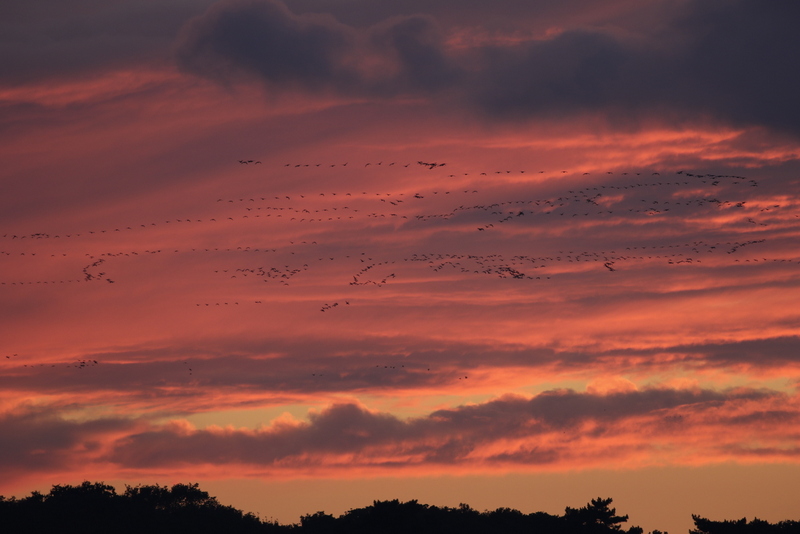

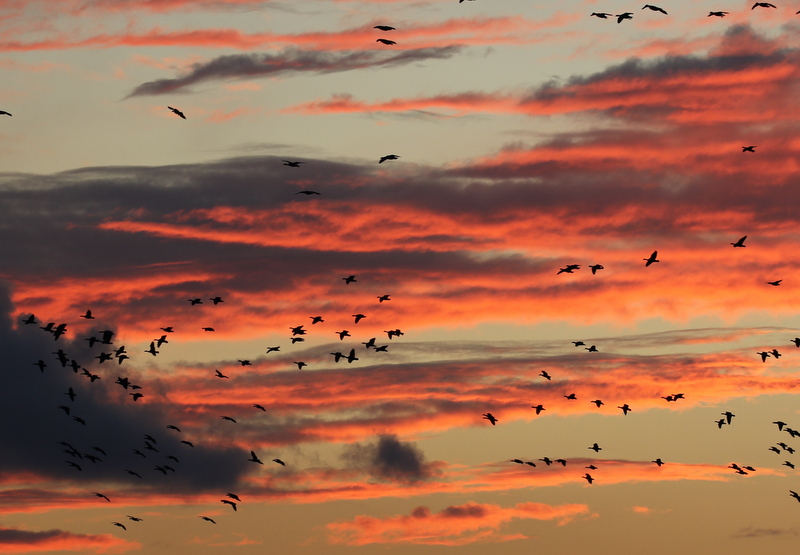
 Pink-footed Geese – coming in to roost at Holkham at sunset
Pink-footed Geese – coming in to roost at Holkham at sunset
















